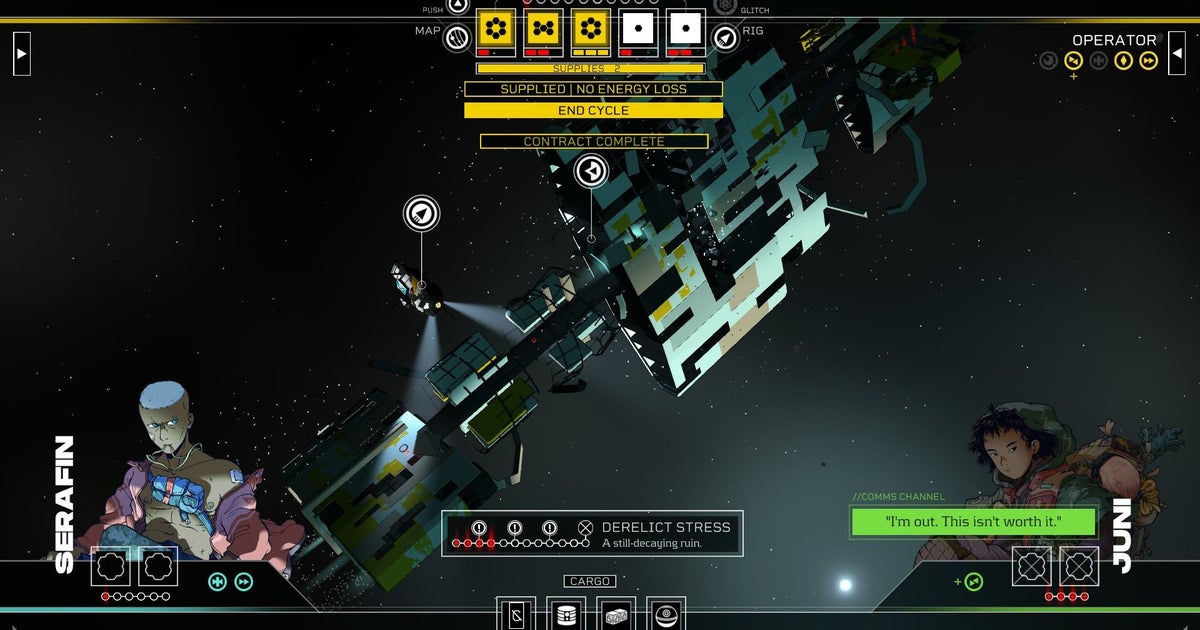No, it’s not Silversun. Sit down, Brian. Let somebody else have a go at answering. Citizen Sleeper 2: Starward Vector is a sci-fi RPG with plenty of dice and a heavy nod towards tabletop role-playing. The first Citizen Sleeper saw your bio-robotic protagonist landing on a donut-shaped space station where they learned to make a new life for themselves among interstellar farmers and ramen-serving rapscallions. In the sequel, a demo of which I’ve played [smug face], the hook is a little different. This time you’re being pursued across a bunch of backwater truck stops, colonies, depots, and derelicts. All the while your misfit crew will clash and commingle. You still haven’t got it, have you? Ugh. I suppose I’ll let the game’s designer tell you then.
“I absolutely love Farscape,” says Gareth Damian Martin, the game’s designer and head of studio Jump Over The Age. “I think the fun thing about Farscape is all the characters are on the run from something, and the only reason they’re all on the ship together is because they were all prisoners on the same prison ship. And I really like that as a hook.”
Farscape was a fun-loving, off-kilter space show featuring a cast of criminal aliens and a single human with the familiar noughties penchant for pop culture references. Citizen Sleeper 2 does not aim for all those notes, judging by my brief playthrough of an early part of the game, but the setup is similar.
“I’ve always wanted to make one of these crew-and-ship games,” says Martin. “I spent years desperately waiting for ones to come out that I might enjoy, and none of them really hit the spot.
“I like it in Farscape where, occasionally, there’ll be an episode where they’re really on-the-run… and then there’ll be an episode where it’s like, oh, there’s no threat right now…”
Martin does cite other references as inspiration of course. Deep Space 9, William Gibson, even Tintin gets a shout-out (“I always loved the way that Tintin would just sometimes get knocked out…”). But it’s the ragtag recklessness of Farscape that seems to be flavouring the RPG sequel.

“I’m always a big fan of this regular-person-forced-into-desperate-circumstances type story, and improvisation, and trying to make things work,” says the developer. “I’m not a big fan of stories about powerful heroes.”
It’s worth saying, however, that the quietly caring tone of the first game’s writing remains intact. I certainly didn’t see anything as capital-K Kooky as Ben Browder arguing about pizza with a wrinkly man in a sadomasochism suit (even as an enjoyer of Farscape, this is a relief). My adventures in the demo saw my character arriving at a rough space station of mechanics and dockworkers. Much of it was taken up with the tutorialising needed to get used to the game’s dice-assigning decision making, which is mostly similar to the first game.
Each day you roll a handful of dice and float around the station or ship you’re docked to, dragging your dice into little boxes to take actions. Eat food at the canteen to restore some energy. Gamble with the losers at the docking bay. Schmooze with the spacewelders to see if you can get a lead on some ship parts you desperately need. The higher the dice you insert, the better chance you have to be successful. It’s simple, clean, yet gets more complex as you progress. As a storytelling device, it also presents some challenges.

“When you make games you have to accept that you are inherently quantifying absolutely
everything,” says Martin, “because a game is just a load of numbers. And so even if the player can’t see those numbers, they definitely exist.
“It’s fun to push and pull at that, and have the player… maybe sometimes feel uncomfortable, if they’re telling their favourite character what to do. I love the idea of that kind of narrative gameplay infecting the mechanical gameplay.”
Martin is specifically talking about the “contracts” you’ll be doing, often as part of a team. This is a new feature for the sequel, and it’s where that “merry band of misfits” flavour comes to the fore. When heading out to a contract, you can choose extra crew members to accompany you, and they’ll get their own dice added to your pool. But they will also take “stress” damage at any failed rolls. I didn’t get to see what happens, in terms of dialogue, when the stress gets too much for anyone. But I did get into a dramatic disagreement with a hacker-historian called Juni who I took on a mission to retrieve an old data core. Juni was nice. Pity I had to abandon her on a derelict ship… I’m sure she’s fine.

Citizen Sleeper was always at its best when it leaned heavily into these troubled relationships, so I’m glad to see more options in the sequel for both kindness and desperate acts of skulduggery. Martin might look to daft Jim Henson extraterrestrials for some inspiration, but it is clear the game also wants to wade into the dark lake of big questions that sci-fi and cyberpunk traditionally enjoy dunking their readers into.
“I think the central hinge of the Citizen Sleeper universe is the question of: is it depressing that, despite all of life and the connections we can have with people, ultimately our lives are dictated by forces outside our control, that can destroy us at any moment? Or is it incredibly beautiful that, in spite of these structures, we can create connections and meaning that can never really be taken away from us?”


“Both” is the implied answer offered by this sometimes-sorrowful, sometimes-hopeful universe. The sequel is set in a region of space called the Starward Belt (fans of the first game might recognise the name of the region, and a few familiar characters who have escaped towards it…). But in the distant regions adjacent to this, there are rumbles of a war, of pain and injustice. It’s one way in which Martin hopes to use sci-fi as a mother-of-pearl mirror to our own world, a parallel for those of us looking on from afar as war continues in Ukraine and Palestine. But this is not the only way in which Martin hopes to reflect troubles they have felt in the present day.
“I think one thing that I am exploring more is how people treat you as a Sleeper,” says Martin. “I think the level of hostility I felt growing towards non-binary, or people who don’t present conventionally in the UK, is quite shocking.
“I think that’s something that’s happening in Citizen Sleeper a lot more. There’s more characters who, when they look at you in a certain way, it reminds you that you’re a Sleeper and what that means, and what your position is.”

Martin, who is non-binary too, says they don’t always want to hide the issue beneath layers and layers of subtext either. One of the characters of the first game (I won’t spoil who) returns in this instalment, having put aside all gender markers. Yet Martin also simply wanted to bring this person back out of a natural desire to pick up a story that was intentionally left hanging.
“I leave myself a lot of loose ends constantly when I’m writing. And then I decide which ones I’m going to pick up… In Citizen Sleeper 1 there’s a lot of characters who do go off to the Starward Belt, and so for me it was just obvious that if I’m going to go to that place, it’s really fun to pick back up those loose ends and see where they go.
“Sometimes I’ll write half a story, and then I’ll just leave a loose end there and I’ll come back and finish it later in development… it feels like part of the process of making Citizen Sleeper is just weaving these stories together. That happens much more naturally if it’s all loose ends.”
I’m up for that. So long as we’re not left too wanting. Citizen Sleeper 2 is not even out yet, but considering how quickly Martin committed to more stories in this universe following the first game (it was barely out a year before the sequel was confirmed) I can’t help but ask if there are plans to round it off as a trilogy. However, it sounds like the developer might take a longer break this time.

“I certainly wouldn’t immediately go onto working on Citizen Sleeper 3,” says Martin. “DLC will be about whether or not I feel that there’s a space for it, how much stuff I get in the game that I want. But I think for me there’s also definitely a moment coming up very soon where I will be ready to be, like, let’s make the Citizen Sleeper tabletop game…”
When Farscape concluded as a TV series in 2003 it had some loose ends of its own. The producers had to scramble to put together a 2-episode miniseries that would explain how certain characters might survive being disintegrated into thousands of tiny pieces. But they did it. I don’t know how the Sleeper saga will end some day, but I’m confident my dice-rolling and decision-making will make a similarly neat bow of absolutely finished business. No unresolved tensions here. No, sir. What’s that you ask? Juni? Uh. She’s, yeah, probably out there. Somewhere.
I’m sure she’s over it.

